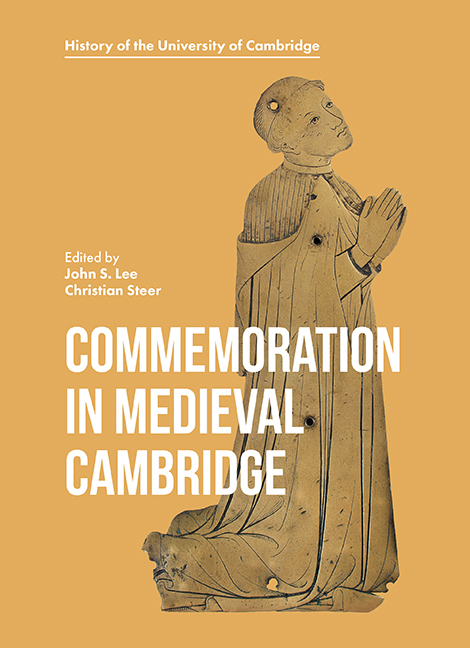Book contents
- Frontmatter
- Contents
- List of Illustrations
- Acknowledgements
- List of Contributors
- Abbreviations
- Introduction: In Fellowship with the Dead
- 1 Monuments and Memory: A University Town in Late Medieval England
- 2 The Commemoration of the Living and the Dead at the Friars Minor of Cambridge
- 3 The City of London and the Founding of the Guild of Corpus Christi
- 4 Patrons and Benefactors: The Masters of Trinity Hall in the Later Middle Ages
- 5 A Comparison of Academical and Legal Costume on Memorial Brasses
- 6 Commemoration at a Royal College
- 7 Cambridge Commemorations of Lady Margaret Beaufort's Household
- 8 ‘The Stones are all disrobed’: Reasons for the Presence and Absence of Monumental Brasses in Cambridge
- Bibliography
- Index
7 - Cambridge Commemorations of Lady Margaret Beaufort's Household
Published online by Cambridge University Press: 25 October 2019
- Frontmatter
- Contents
- List of Illustrations
- Acknowledgements
- List of Contributors
- Abbreviations
- Introduction: In Fellowship with the Dead
- 1 Monuments and Memory: A University Town in Late Medieval England
- 2 The Commemoration of the Living and the Dead at the Friars Minor of Cambridge
- 3 The City of London and the Founding of the Guild of Corpus Christi
- 4 Patrons and Benefactors: The Masters of Trinity Hall in the Later Middle Ages
- 5 A Comparison of Academical and Legal Costume on Memorial Brasses
- 6 Commemoration at a Royal College
- 7 Cambridge Commemorations of Lady Margaret Beaufort's Household
- 8 ‘The Stones are all disrobed’: Reasons for the Presence and Absence of Monumental Brasses in Cambridge
- Bibliography
- Index
Summary
Lady Margaret Beaufort (1443–1509) is familiar to both scholars and the general public as the grand matriarch who engineered the marriage of her son, Henry VII, to Elizabeth of York, and in doing so united the warring Houses of Lancaster and York. Her household papers at St. John's College, Cambridge, date from 1498, when, at the age of fifty-five, Lady Margaret separated from her husband, Thomas Stanley, first earl of Derby, and ran her own household as femme sole. Stanley was her third husband. Her first husband, Edmund Tudor, had died before their son, the future Henry VII, was born and after only six months of marriage. Her second (almost immediate) marriage, to Henry Stafford, son of Humphrey, first duke of Buckingham, was longer lasting but produced no offspring. Her third marriage covered her years of maturity, from 1472, when she was approaching thirty, to 1504, when Stanley died. He had been steward to the household of Edward IV when she married him, and after Bosworth he became constable of England and high steward of the duchy of Lancaster, but his lands and principal estates were all in the north-west. Lady Margaret herself owned land and property over a wide area of the Midlands and even in the south-west, but in 1498 she took a vow of chastity (confirmed at Stanley's death) and established a household at Collyweston in Northamptonshire, four miles south-west of Stamford. As far as is known, she never returned to the north-west of England, although Stanley had his own rooms at Collyweston and visited occasionally until his death in 1504.
It is with her separate establishment that Lady Margaret comes into her own, for us at least, because it is from then that we have most evidence of her daily life: most of her household accounts (1498–1509); the accounts of James Morice, her clerk of works; numerous individual documents; and inventories of her chapel and household goods, as well as her executors’ accounts. The household accounts are those of her secretary and dean of chapel, later chancellor, Henry Hornby (1499–1509); her respective cofferers, James Clarell (1498–99), Miles Worsley (1502–09), and Robert Fremingham (1509); the treasurer of her household, William Bedell (1506–07); and her chamberlain, Roger Ormeston (1501–02).
- Type
- Chapter
- Information
- Commemoration in Medieval Cambridge , pp. 123 - 151Publisher: Boydell & BrewerPrint publication year: 2018



